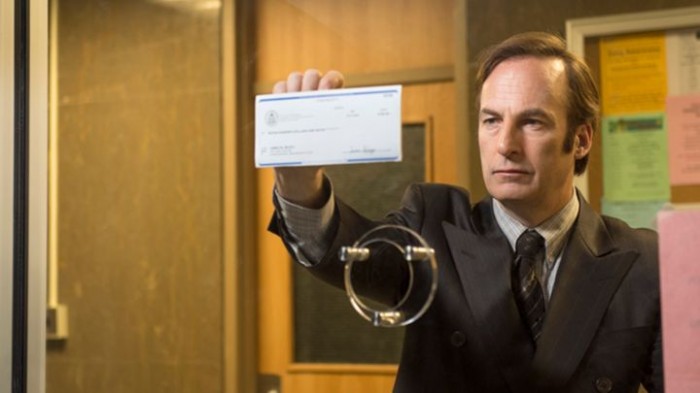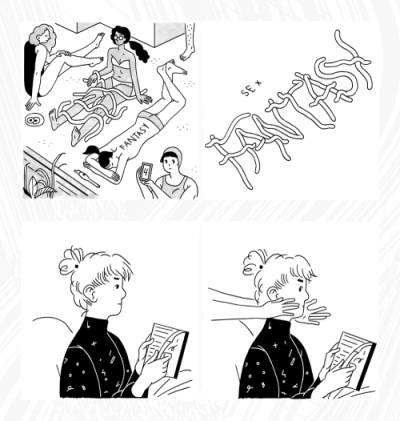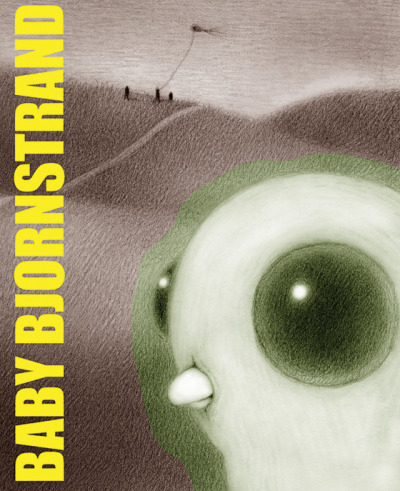I’ve put together a list of my strongest work this year. I hope you enjoy it.
Comics
My partner, the artist and cartoonist Julia Gfrörer, and I made several comics together this year:
“Hiders,” a four-page short story about werewolves and secrets, available for purchase in Study Group Magazine #3D.
“The Deep Ones,” a four-page exploration of sea monsters, semiotics, and why we fear the ocean, published on The Nib and available for purchase in the “Deep Trouble” issue of Symbolia magazine.
The Hideous Dropping Off of the Veil, a pornographic extrapolation of “The Fall of the House of Usher” by Edgar Allan Poe and the second in our ongoing “Poe porn” series, available for purchase from Julia.
Additionally, my two collaborations with cartoonist Jonny Negron now have new homes on the web:
Flash Forward, a horror comic about seeing and being seen, can now be read at StudyGroupComics.com.
No Way Out for a Family of Five, a horror comic about the revenge of the repressed, can now be read at The True Black, the dedicated tumblr for my comics.
Finally, the cartoonist Colin Panetta and I collaborated on “What Is Nigeria?”, a comic about punditry, empathy, and the American gaze based on the Vox.com article “9 Questions About Nigeria You Were Too Embarrassed to Ask” by Max Fisher.
TV Criticism
I wrote about TV regularly for Rolling Stone and the New York Observer this year, reviewing Boardwalk Empire, The Leftovers, Halt and Catch Fire, Game of Thrones, True Detective, and Downton Abbey for the former and The Comeback and The Wire for the latter. I also reviewed Mad Men for Wired. If you click on each title you’ll be linked to the piece I was happiest with for each show; spoiler alert, obviously. I included two links for Boardwalk Empire because I’m very proud of the work I did on that series, which in my estimation is one of the best ever to air.
I did plenty of TV writing outside the weekly review/recap format as well. My favorites:
Of everything I wrote about anything this year, this piece on Unedited Footage of a Bear, Too Many Cooks, Tim and Eric’s Bedtime Stories, and the new wave of Adult Swim horror is my favorite.
My lists of the Top 40 Game of Thrones characters, the Top 30 Twin Peaks characters, and the A-to-Z of Lost enabled me to express a great deal of what’s important to me about each show.
I wrote 14 of the 16 entries for Rolling Stones tournament of TV’s Most Shocking Moments — a real journey through the length and breadth of the New Golden Age and its immediate antecedents, with a variety of definitions for both “shocking” and “moments.”
I faced off against Eric Thurm in a he said/he said debate about The Affair, which I think was the best new series of the year.
I also debated Hazel Cills about the value of Don Draper to Mad Men for Netflix, and discussed Mad Men‘s deliberate self-destruction of its Rat Pack retro stylistic appeal for Esquire.
Also for Esquire, I talked about True Detective and how grand unified theories about TV-show mysteries miss the goddamn point.
I explained how Andy Daly’s Review is a satire of New Golden Age antihero dramas hiding in plain sight.
I wrote a defense of Twin Peaks when it was lumped in with other “dead girl shows” like True Detective.
I talked about a controversial episode of Game of Thrones as a failure of filmmaking rather than a failure of morals, ethics, or politics.
I kept on writing about Downton Abbey even after I stopped doing so for Rolling Stone.
Finally, I’m a founding and regular panelist on Spoiler Alert, HuffPost Live’s semiweekly television talk show. I recommend the episode where we beat the tar out of The Newsroom‘s penultimate installment.
Interviews
I spoke with many talented people this year about their work. Some favorites:
Anita Sarkeesian, feminist video game critic; I believe this was my most popular piece this year by an order of magnitude
Terence Winter, creator of Boardwalk Empire
Rory McCann, aka Sandor “The Hound” Clegane, from Game of Thrones
Neil Marshall, director of The Descent, Centurion, and the “Blackwater” and “The Watchers on the Wall” episodes of Game of Thrones
Meghan Turbitt and Leah Wishnia, cartoonists, for my recently revived Comics Journal up-and-comer interview column Say Hello
Comics Criticism
I resumed writing about comics regularly this summer after a lengthy hiatus, mostly at The Comics Journal. Again, some favorites:
Earthling by Aisha Franz
Gast by Carol Swain
Sex Fantasy by Sophia Foster-Dimino
July Diary 2014 by Gabrielle Bell
This One Summer by Mariko Tamaki and Jillian Tamaki
I also listed the five best comics of the year.
Finally, my review of How to Be Happy by Eleanor Davis was complimented by Gary Groth, a hero.
A Song of Ice and Fire
I am a tremendous admirer George R.R. Martin’s epic fantasy series A Song of Ice and Fire, the basis for Game of Thrones. I write and talk about it a lot, so much so that it’s honestly hard for me to remember stand-outs. I suppose I’d just suggest you follow my dedicated blog for that material boiledleather.com, on tumblr if that sort of thing interests you.
That said, Stefan Sasse and I co-host a podcast on the series called The Boiled Leather Audio Hour. My favorite episodes this year include our reviews of Game of Thrones Season Four; The World of Ice and Fire , the in-world encyclopedia for the books; the Tales of Dunk and Egg, a series of prequel novellas; and “The Rogue Prince,” a faux-historical novella chronicling an earlier time period.
I listed the 12 craziest things we learned from The World of Ice and Fire for Rolling Stone.
Finally, I made $60, eventually.
…and the rest
I wrote about how sociopolitical analysis, source-text purism, theory-mongering, and shipping/stanning/bad-fan behavior are connected by a common desire to create a falsely objective approach to the inherently subjective fields of art and criticism.
I wrote about how Velvet Goldmine changed my life.
I wrote about the Mines of Moria sequence in The Fellowship of the Ring and what it taught me about action in visual narrative art.
I wrote about Ferguson.
I made a scary Halloween mix called BLACK FRIDAY.
Writer and musician Hether Fortune interviewed Julia Gfrörer and I about our first pornographic Poe adaptation, In Pace Requiescat, for Slutist.
Julia and I maintained several tumblrs together:
The Devil in Love: images of the infernal with undeniable erotic or aesthetic appeal.
The Deep Ones: sea monsters, real, extinct, and imaginary.
Homage to Catalonia: churches on fire or in ruins.
Comics Democracy: comics with over 10,000 notes on tumblr, reblogged without comment.
This happened.

This happened.

This and this happened.


I spent the first full year of my life as a full-time freelance writer, I fell deeper in love with an astonishing woman, I helped parent a marvelous child.
See you next year.











